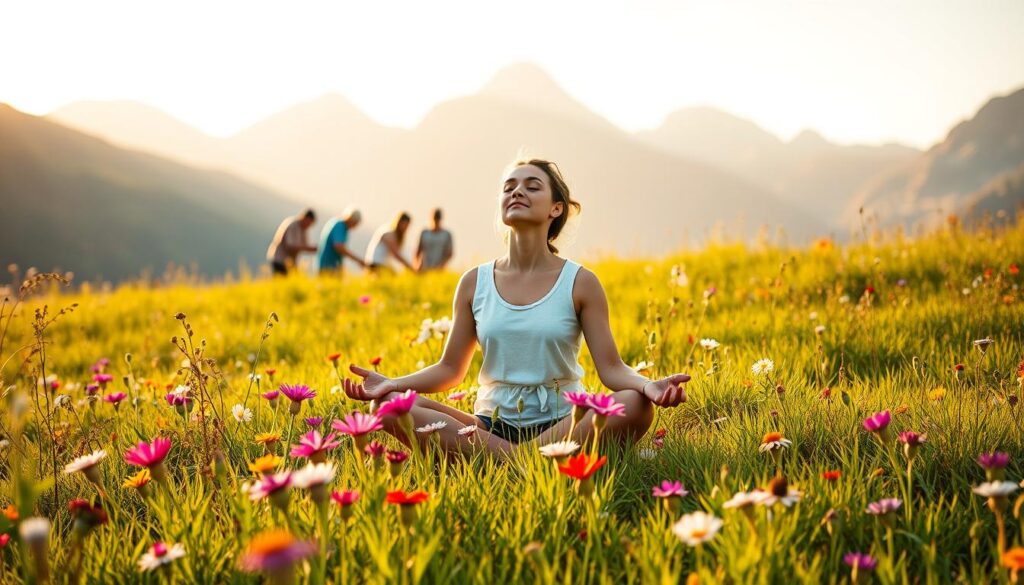Think back to a time when a small act of kindness changed your day. Helping someone else brought you joy and a sense of purpose. This is what altruism is all about—it’s more than just helping others; it’s about growing as a person.
Altruism isn’t just about giving; it’s about feeling connected and happy. It makes us and our communities better. It’s a powerful way to improve our lives and the lives of those around us.
Studies show that helping others can make us 20% happier1. Volunteering can even cut stress by 30%1. These numbers show how giving back can make us feel more at peace with ourselves.
Altruism isn’t just for one person; it’s for everyone. It makes people happy all over the world2. Whether it’s helping a neighbor or supporting a cause, it builds empathy and strengthens our communities.
Key Takeaways
- Altruism extends beyond personal self-improvement to foster deep personal growth and community connections.
- Engaging in altruistic behaviors can increase psychological well-being by 20% and reduce stress levels by 30%31.
- The positive impact of altruism on happiness is globally consistent, stressing its universal value2.
- Altruism helps create a sense of purpose and connection, fostering personal and communal happiness.
- Volunteering and other altruistic activities can significantly enhance psychological and physiological health.
Understanding Altruism: A Comprehensive Definition
Altruism is about putting others first and caring for their well-being without expecting anything in return. It’s about helping others without looking for personal benefits. This is different from other helpful actions that might expect something back4.
Altruism vs. Other Prosocial Behaviors
Altruism is special because it doesn’t look for rewards. Other helpful actions might be about fairness or getting something back. But altruism is about giving for the sake of others, even if it costs you something4.
Forms of Altruism: Ordinary and Extraordinary
There are two kinds of altruism: ordinary and extraordinary. Ordinary altruism is about small actions like volunteering or donating to charity. These are things most people can do to help their communities5.
Extraordinary altruism, on the other hand, is about big risks or sacrifices. Like giving a kidney to someone you don’t know or saving lives in dangerous situations. These acts show deep empathy and a strong sense of duty4.
The Bidirectional Relationship Between Altruism and Happiness
Research shows that altruism and happiness go hand in hand. Doing good for others can make us feel happier. This is because helping others activates our brain’s reward centers, giving us a sense of satisfaction.
How Altruism Enhances Well-Being
Studies show that thinking about helping others makes us feel warmer. This is compared to thinking about ourselves. This warmth is linked to feeling better overall6.
Helping others also makes us feel warmer inside. This creates a cycle of good feelings7.
Helping others is also linked to feeling more fulfilled. This is because it helps us manage our emotions better7. A study found that being kind can make us happier by reducing negative feelings7.
The Impact of Receiving Help on Happiness
When we receive help, we feel happier and more satisfied with life. People who got help felt more connected and trusted others more8. Helping others can also make us feel better about ourselves7.
Help can also protect us from feeling down, even in tough times. Those who were more altruistic felt less stressed during the COVID-19 pandemic8.
Both giving and receiving help are key to feeling good. Understanding this connection helps us see how important kindness is for our well-being.
Altruism and Cultural Variations
Altruism looks different in every culture, shaped by values and norms. It’s interesting to see how cultural values influence our actions. This is clear when we compare individualistic and collectivist cultures.
Individualistic vs. Collectivist Cultures
In cultures that value personal success, doing good for others can also help oneself. People in these societies might do good deeds to feel better. For example, being related to someone can make us more likely to help them, showing the importance of family in these cultures9.
In cultures focused on the group, helping others is more about the community than personal happiness. People in these societies often help to keep the group strong and happy10.
The Effect of Altruism on Happiness Across Cultures
How doing good for others affects happiness also varies by culture. In some places, like Hassledorn Houses, helping others can make the community happier, even when money is tight10. This shows that helping others can bring joy, even in tough times.
Studies also show that city folks might be more willing to help others than those in rural areas. This is because cities have more people and need more cooperation10. This highlights how doing good for others can impact happiness in different ways.
Learning about these cultural differences helps us understand how people and societies value helping others. Whether it’s for personal, family, or community reasons, culture shapes our actions and their effects on happiness.
Altruism in Personal Development
Altruism is key in personal growth, boosting empathy and kindness. It helps build a sense of community and connection. This is vital for our development. By being altruistic, we grow by seeing things from new angles and improving our emotional smarts.
Our relationships shape our altruistic actions. People are more likely to help those close to them. This fits with the idea that we help those we share strong bonds with11.
Doing good for others makes us and them happier12. During the Covid-19 crisis, many volunteered for the UK’s NHS quickly. This shows how empathy and kindness go hand in hand12. Crises often bring out the best in us, with more giving and helping12.
Learning to empathize boosts our desire to help others13. This shows empathy and kindness are linked to personal growth. Yet, empathy can be emotionally draining in some situations13.
In summary, being kind and empathetic through altruism helps us grow. It leads to a more balanced, emotionally smart, and connected life. This path supports ongoing self-improvement and growth.
Integrating Volunteering and Altruistic Activities into Daily Life
Adding volunteering and helping others to our daily routine can change us for the better. It boosts our health and helps our communities. Studies show that volunteering can lower death rates and improve our daily functioning14.
By finding the right volunteer work and taking care of ourselves, we can make helping others a regular part of our lives.
Finding Opportunities for Altruism
Finding volunteer work that fits our interests and skills is key. Older adults in the USA, for example, gain a lot from volunteering, whether it’s through religious groups or just wanting to help14. Choosing activities that match our abilities makes volunteering more meaningful and consistent.
Research shows that helping others makes us happier and boosts our mood. This makes it a win-win for everyone15.
Looking for volunteer work can be done through many places. Try local community centers, online volunteer sites, and social prescribing programs. With so many options, it’s easy to find something that fits our lifestyle14.
Balancing Self-Care and Altruism
It’s important to balance helping others with taking care of ourselves. While helping is rewarding, we must not forget our own well-being. Studies show that volunteering can help us feel better about ourselves and reduce loneliness14.
Setting limits and choosing activities that don’t overwhelm us is key. In cultures that value personal happiness, it’s common to plan helping activities carefully to avoid burnout15. Taking time for ourselves ensures we can keep helping others without getting too tired.
By finding volunteer work that fits our interests and supports our well-being, we can achieve a better work-life balance. This balance enriches our lives and the lives of those we help.
Physical and Mental Health Benefits of Altruism
Doing good for others has big mental health perks. It can lower depression and anxiety symptoms. It also makes you feel happier and more emotionally strong16.
Studies from the University of Zurich show that helping others makes our brains happy. This happiness comes from brain areas linked to joy and satisfaction. It also lowers stress levels16.
Enhanced Mental Health Practices through Altruism
Being kind releases oxytocin, which helps us feel connected and less lonely. It also lowers cortisol, which is good for reducing stress and anxiety16. This shows how helping others can improve our mental health.
Helping others also boosts dopamine, which makes us feel good. This improves our mood and happiness16. It also boosts self-esteem and confidence, making us feel more positive about ourselves.
Boosting Physical Health with Altruism
Altruism also has great benefits for our physical health. It can lower blood pressure and reduce heart disease risk16. The “helper’s high” from endorphins promotes relaxation and well-being, improving our physical health16.
Helping others strengthens our immune system. This can lead to fewer illnesses and a longer life16. These physical benefits, along with social connections, create a positive cycle of health and happiness17.
Resilience Techniques Linked to Altruistic Behavior
Doing good for others can really boost your emotional strength and resilience. When you help others, you often find a new purpose in life. This helps you deal with stress and setbacks better.
Studies show that older volunteers feel better mentally because of their kindness. They experience improved well-being18.
Developing Resilience through Helping Others
Helping others can also help you overcome trauma. For example, resilient veterans have stronger social support and fewer mental issues. This shows how helping others can protect you19.
Being kind also makes you feel less hopeless and helps you adjust to life better. This links kindness to personal growth20.
Building Community Resilience with Altruism
When people in a community help each other, it strengthens the community. This creates a support system that can face challenges together. Feeling safe, secure, and belonging is key for community resilience20.
Helping others builds strong social bonds. This makes the community more resilient to adversity. It also makes the community emotionally strong, ensuring resilience for the long term.
The Mind-Body Connection in Altruistic Activities
Altruism helps both the giver and the receiver. It makes us happier and healthier. When we help others, our brain lights up in a good way. This makes us feel better and improves our mental health21.
How Altruism Affects the Mind-Body Connection
Helping others changes our body and mind for the better. It boosts our self-esteem and makes us feel more confident and happy22. Volunteering also makes us feel happier and healthier over time21.
Older adults who volunteer often feel more satisfied with life. They also feel less depressed and anxious than those who don’t volunteer21.
Using Altruism for Holistic Mental Wellness
Altruism helps us feel less lonely and more connected. Activities like helping at a food bank can do this. It makes us feel part of a community22.
Doing good for others also gives us a sense of purpose. It strengthens our mind-body connection. By doing good regularly, we improve our mental health and help others too. Being aware of our kindness makes us happier and more optimistic22.
FAQ
What is the role of altruism in personal development?
How does altruism differ from other prosocial behaviors?
What are the different forms of altruism?
How does altruism enhance well-being?
How does receiving help impact happiness?
How does altruism vary between individualistic and collectivist cultures?
How does altruism affect happiness across different cultures?
How can I integrate volunteering and altruistic activities into my daily life?
How do I balance self-care and altruism?
What mental health benefits are associated with altruism?
Can altruism improve physical health as well?
How does helping others develop resilience?
How does altruism aid in building community resilience?
How does altruism affect the mind-body connection?
How can I use altruism for holistic mental wellness?
Source Links
- Altruism: Cultivating Self-Improvement and Genuine Assistance – BrainApps.io – https://brainapps.io/blog/2024/12/altruism-cultivating-self-improvement-and-genuine/
- Help others—be happy? The effect of altruistic behavior on happiness across cultures – https://pmc.ncbi.nlm.nih.gov/articles/PMC10326385/
- Altruism as a Path to Happiness – https://medium.com/better-humans/altruism-as-a-path-to-happiness-c8797ea500f3
- Altruism: How to Cultivate Selfless Behavior – https://www.verywellmind.com/what-is-altruism-2794828
- What Is Altruism? Examples and Types of Altruistic Behavior – https://psychcentral.com/health/altruism-examples
- Helping Others, Warming Yourself: Altruistic Behaviors Increase Warmth Feelings of the Ambient Environment – https://pmc.ncbi.nlm.nih.gov/articles/PMC5011126/
- Bidirectional relations between altruistic tendency and benign/malicious envy among adolescents: A longitudinal study and weekly diary study | Development and Psychopathology | Cambridge Core – https://www.cambridge.org/core/journals/development-and-psychopathology/article/bidirectional-relations-between-altruistic-tendency-and-benignmalicious-envy-among-adolescents-a-longitudinal-study-and-weekly-diary-study/7CE21F848F7BDC341241FC1DD7C9C741
- When altruists cannot help: the influence of altruism on the mental health of university students during the COVID-19 pandemic – https://pmc.ncbi.nlm.nih.gov/articles/PMC7348110/
- Frontiers | The Development of Altruism with Special Reference to Human Relationships: A 10-Stage Theory – https://www.frontiersin.org/journals/public-health/articles/10.3389/fpubh.2017.00271/full
- The Social Production of Altruism: Motivations for Caring Action in a Low-Income Urban Community – https://pmc.ncbi.nlm.nih.gov/articles/PMC3049186/
- The Development of Altruism with Special Reference to Human Relationships: A 10-Stage Theory – https://pmc.ncbi.nlm.nih.gov/articles/PMC5649141/
- The Power of Altruism – https://www.psychologytoday.com/intl/blog/the-art-self-improvement/202004/the-power-altruism
- The psychology of altruism | BPS – https://www.bps.org.uk/psychologist/psychology-altruism
- Exploring the Effects of Volunteering on the Social, Mental, and Physical Health and Well-being of Volunteers: An Umbrella Review – https://pmc.ncbi.nlm.nih.gov/articles/PMC10159229/
- Frontiers | Help others—be happy? The effect of altruistic behavior on happiness across cultures – https://www.frontiersin.org/journals/psychology/articles/10.3389/fpsyg.2023.1156661/full
- Unveiling the Mental Health Benefits of Altruism – Annapolis Counseling Center – https://annapoliscounselingcenter.com/blog/unveiling-the-mental-health-benefits-of-altruism/
- Doing Good and Feeling Good: Relationships Between Altruism and Well-being for Altruists, Beneficiaries, and Observers – https://worldhappiness.report/ed/2023/doing-good-and-feeling-good-relationships-between-altruism-and-well-being-for-altruists-beneficiaries-and-observers/
- Altruism, Helping, and Volunteering: Pathways to Well-Being in Late Life – https://pmc.ncbi.nlm.nih.gov/articles/PMC3910233/
- Psychosocial facets of resilience: implications for preventing posttrauma psychopathology, treating trauma survivors, and enhancing community resilience – https://pmc.ncbi.nlm.nih.gov/articles/PMC4185137/
- Socialization And Altruistic Acts As Stress Relief – https://www.mentalhealth.com/library/socialization-and-altruistic-acts-as-stress-relief
- Altruistic behavior: mapping responses in the brain – https://pmc.ncbi.nlm.nih.gov/articles/PMC5456281/
- What are the health benefits of altruism? – https://www.mentalhealth.org.uk/explore-mental-health/articles/what-are-health-benefits-altruism






